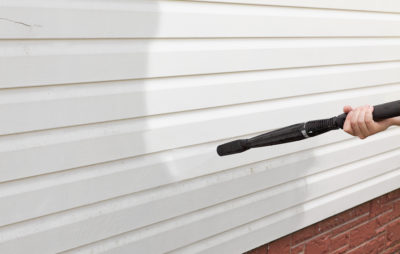How to Pressure Wash Your Siding

Pressure washing your home’s siding is no small job. Before you start, make sure you have all of the necessary supplies. You will need a pressure washer, eye protection, drop cloths, a garden hose and pressure water detergent. Some pressure washers work different than others. Be sure to read the instructions for your particular pressure washer model before starting.
Close all of your home’s windows and doors by the siding. Also, take care to protect your home’s external outlets. Tape them down with plastic so they are fully covered. This way, water won’t be able to breach these sensitive openings. Turn off the power to these external outlets as an extra precaution. Finally, remove all obstacles around the siding that could cause you to trip or become caught in the hoses. It will also help to trim overgrown plants that touch your home’s exterior.
How to Pressure Wash Your Siding
If any of the siding has been damaged, repair or replace those sections before commencing. Stand on a sturdy surface when operating the pressure washer. Pressure washers are powerful machines that can jolt the user from side to side and back and forth. Hold onto it tightly and spray small sections of the siding, starting at the bottom and moving upward. Washing in this fashion prevents streaking from remaining on the surface following the project’s completion.
Make use of detergents that are strictly meant for pressure washing projects. Use a low-pressure setting when applying the detergent. Try to spray outside of gaps like the spaces around windows and doors. If your house has overlapping side panels, spray across the upper panel and onto the one it overlays. Try to avoid spraying below the bottom portion of the panels.
Pressure Washing Brick and Mortar
If any of the joints are damaged, patch them and give the patches some time to dry. This could take upwards of a full week. Once they have dried, you can clean the brick. Start off with a low-pressure spray application before applying the detergent. The purpose of this saturation is to prevent the detergent from seeping into the brick.
Stand away from the brick when spraying so the water does not rebound and splash back at you. Clean off the brick and you might notice a powdery material known as efflorescence. This is the residue of salt that pulls moisture out of the brick. You can remove this material by scrubbing it with a dry wire brush.
Wood Siding
Wood siding should be sprayed with water before the detergent is applied. Also, be sure to repair damaged or cracked wood panels before pressure washing commences.
Vinyl
Take stock of the vinyl siding’s condition before pressure washing. Avoid spraying spaces where the panels overlap along the window frames and doors.
Stucco
Stucco cracks and chips also need to be patched. Give these patches a fully week to dry before you pressure wash. Try to spray at a 45-degree angle. This angle will help protect the stucco’s texture. Also, be sure to hold the pressure washer’s nozzle at least two feet from the stucco while spraying. If the surface has rust or copper stains, use a soft brush and a specialized rust removal solution to clean them. Spray water out of a garden hose to clean this solution.
Aluminum Siding
The most important thing to consider when pressure washing aluminum siding is the panel overlaps. Do your best to avoid spraying up into these sensitive spaces. Mind the angle at which you hold the pressure washer to avoid causing damage to panel overlaps.
Pressure washing your siding keeps your house looking clean and gives it a nice curb appeal. If you wish to pressure wash your house, make sure you have all of the supplies you need, and don’t forget to make sure that everything that can be water damaged is sealed on the outside of your house.

